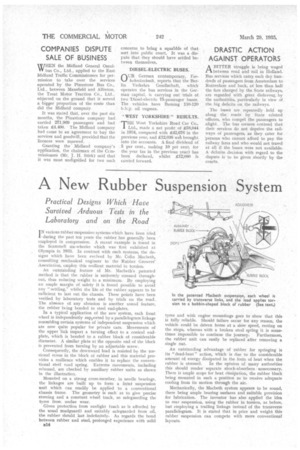A New Rubber Suspension System
Page 120

If you've noticed an error in this article please click here to report it so we can fix it.
I N various rubber suspension systems which have been tried • during the past ten years the rubber has generally been employed in compression. A recent example is found in the Scammell six-wheeler which was first exhibited at Olympia in 1-933. In contrast with such systems, the de.. signs which have been evelved by Mr. Colin Macbeth, consulting mechanical engineer to the Rubber Growers' Association, employ this resilient material in torsion.
An outstanding feature of Mr. Macbeth's patented method is that the rubber is uniformly stressed throughout, thus reducing weight to a minimum. By employing an ample margin of safety it is found possible to avoid any "settling," whilst the life of the rubber appears to be sufficient to last out the chassis. These points have been verified by laboratory tests and by trials on the road. The absence of any abrasion is another sound feature, the rubber being bonded to steel end-plates.
In a typical application of the uew system, each front wheel is independently supported by a parallelogram linkage resembling certain systems of independent suspension which are now quite popular for private cars. Movements of the upper link impart a turning effect to a conical endplate, which is bonded to a tubber block of considerable diameter. A similar plate at the opposite end of the block is prevented from turning by an adjustable screw.
Consequently, the downward load is resisted by the torsional stress in the block of rubber and this material provides a resilience which enables it to replace the conventional steel toad spring. Extreme movements, including rebound, are checked by auxiliary rubber units as shown in the illustration.
Mounted on a strong cross-member, in needle bearings, the linkages are built up to form a freint suspension unit which can readily be applied to a conventional chassis frame. The geometry is such as to give precise steering and a constant wheel track, so safeguarding the tyres from undue wear.
Given protection from sunlight (such as is afforded by the usual mudguard) and suitably safeguarded from oil, the rubber shOuld last indefinitely. As regards the bond between rubber and steel, prolonged experience with solid 131.4 tyres and with engine mountings goes to show that this is fully reliable. Should failure occur for any reason, the vehicle could be driven home at a slow speed, resting on the stops, whereas with a broken steel spring it is some times impossible to continue the journey. Furthermore, the rubber unit can easily be replaced after removing a single nut.
An outstanding advantage of rubber for springing is its 'dead-beat" action, which is due to the considerable amount of energy dissipated in the form of heat when the rubber is stressed. In the opinion of many authorities this should render separate shock-absorbers unnecessary. There is ample scope for heat dissipation, the rubber block being mounted in such a position as to receive adequate cooling from its motion through the air.
Mechanically, the Macbeth system appears to be sound, there being ample bearing surfaces and suitable provision for lubrication. The inventor has also applied the idea to rear suspension, using the rubber in torsion, as before, but employing a trailing linkage instead of the transverse parallelogram. It is stated that in price and weight this rubber suspension can compete with more conventional layouts.




































































































































































